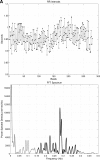Painful diabetic neuropathy is associated with greater autonomic dysfunction than painless diabetic neuropathy
- PMID: 20587724
- PMCID: PMC2890363
- DOI: 10.2337/dc09-2314
Painful diabetic neuropathy is associated with greater autonomic dysfunction than painless diabetic neuropathy
Abstract
Objective: Although a clear link between diabetic peripheral neuropathy (DPN) and autonomic neuropathy is recognized, the relationship of autonomic neuropathy with subtypes of DPN is less clear. This study aimed to investigate the relationship of autonomic neuropathy with painless and painful DPN.
Research design and methods: Eighty subjects (20 healthy volunteers, 20 with no DPN, 20 with painful DPN, 20 with painless DPN) underwent detailed neurophysiological investigations (including conventional autonomic function tests [AFTs]) and spectral analysis of short-term heart rate variability (HRV), which assesses sympathovagal modulation of the heart rate. Various frequency-domain (including low frequency [LF], high frequency [HF], and total power [TP]) and time-domain (standard deviation of all normal-to-normal R-R intervals [SDNN] and root mean square of successive differences [RMSSD]) parameters were assessed.
Results: HRV analysis revealed significant differences across the groups in LF, HF, TP, SDNN, and RMSSD (ANOVA P < 0.001). Subgroup analysis showed that compared with painless DPN, painful DPN had significantly lower HF (3.59 +/- 1.08 [means +/- SD] vs. 2.67 +/- 1.56), TP (5.73 +/- 1.28 vs. 4.79 +/- 1.51), and SDNN (2.91 +/- 0.65 vs. 1.62 +/- 3.5), P < 0.05. No significant differences were seen between painless DPN and painful DPN using an AFT.
Conclusions: This study shows that painful DPN is associated with significantly greater autonomic dysfunction than painless DPN. These changes are only detected using spectral analysis of HRV (a simple test based on a 5-min electrocardiogram recording), suggesting that it is a more sensitive tool to detect autonomic dysfunction, which is still under-detected in people with diabetes. The greater autonomic dysfunction seen in painful DPN may reflect more predominant small fiber involvement and adds to the growing evidence of its role in the pathophysiology of painful DPN.
Figures


References
-
- Dyck PJ, Kratz KM, Karnes JL, Litchy WJ, Klein R, Pach JM, Wilson DM, O'Brien PC, Melton LJ, 3rd, Service FJ: The prevalence by staged severity of various types of diabetic neuropathy, retinopathy, and nephropathy in a population-based cohort: the Rochester Diabetic Neuropathy Study. Neurology 1993; 43: 817–824 - PubMed
-
- Boulton AJ, Kirsner RS, Vileikyte L: Clinical practice: neuropathic diabetic foot ulcers. N Engl J Med 2004; 351: 48–55 - PubMed
-
- Quattrini C, Harris ND, Malik RA, Tesfaye S: Impaired skin microvascular reactivity in painful diabetic neuropathy. Diabetes Care 2007; 30: 655–659 - PubMed
-
- Young RJ, Zhou YQ, Rodriguez E, Prescott RJ, Ewing DJ, Clarke BF: Variable relationship between peripheral somatic and autonomic neuropathy in patients with different syndromes of diabetic polyneuropathy. Diabetes 1986; 35: 192–197 - PubMed
-
- Veves A, Young MJ, Manes C, Boulton AJ: Differences in peripheral and autonomic nerve function measurements in painful and painless neuropathy: a clinical study. Diabetes Care 1994; 17: 1200–1202 - PubMed
Publication types
MeSH terms
LinkOut - more resources
Full Text Sources
Medical
Research Materials
Miscellaneous

